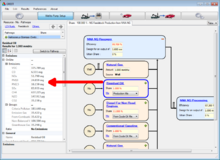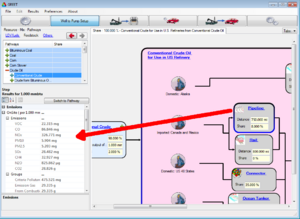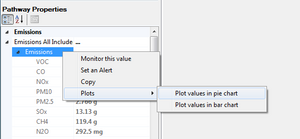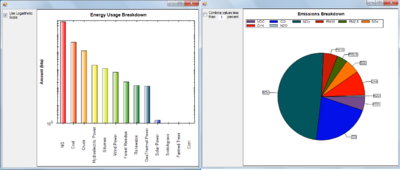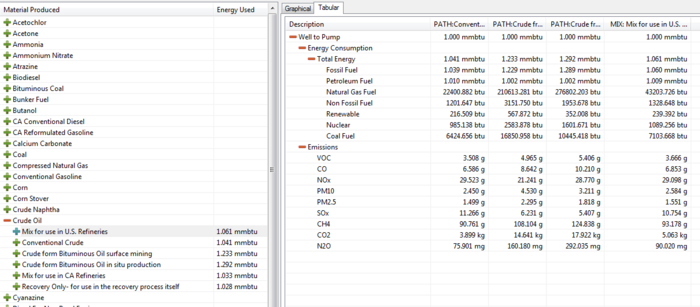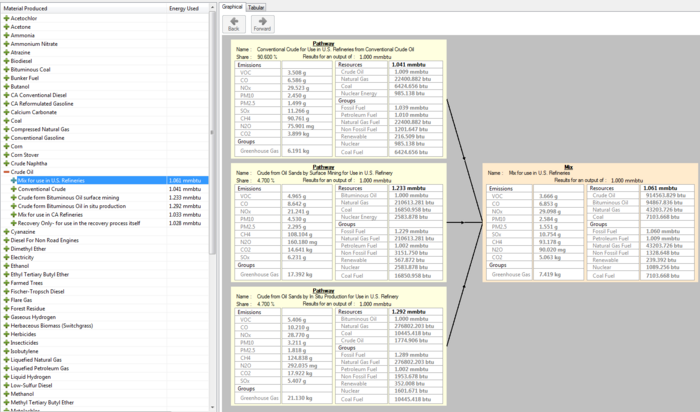Looking at the results
Processes
All the results displayed here are converted in order to respect the unit preferences of the user. For more details about the user unit preferences, please refer to the general preferences page.
Process Properties
Emissions Results
- Emissions All Included :
They represent the "Balance" of the process, or "whatever was released in the athmosphere to get that amount of output". Emission wise it include all the emissions associated to the technologies, the fuel upstream, the upstream from the previous processes in the pathway, and the special emissions like static emissions, group emissions, ratio emissions. It also includes the benefits if there is any credit or co-product in the process. - Emission OnSite + Partial Upstream:
These emissions are the sum of the technologies emissions and the upstream associated to the inputs materials coming from a material Source and the upstream of the input defined by a share. Basically this represents the emissions part of the defined in the calculations above.
- Emissions OnSite without any upstream :
Here we only account the total emissions coming out of this process technologies. No upstream is accounted.
- Losses Emissions :
The losses emissions are the sum of all the losses for that process. The losses are defined with a leakage or a boiloff on any input/output. The amount of material lost is then converted to an amount gas. In order to know which material gets converted into which gas, we are looking in the Materials database.
- Other Emissions :
The other emissions sums up the static process emissions, the group emissions and the ratio emissions.
- Adjustment Emissions :
For information this shows the necessary adjument made on the total emissions amount to respect the min and max emissions.
- Credit Emissions :
The Credit emissions are the sum of all the emissions of the Credits for that process.
Energy Results
- Energy All Included :
This shows whatever was necessary to produce the desired output amount of material. It Includes all the upstream up to this process. This set of values will also include the upstream of the input coming from the previous processes in the pathway. If the process is the last of a pathway, then the values showed here will be the calculated results for the pathway.
- Energy OnSite + Mixes Upstream :
Those results are not including the upstream of the input coming from the previous processes, therefore those values are comparable to the GREET Excel results for a process. However we do not remove the energy content of the main output from that dictionary, that's why for many processes the result displayed here will be higher than what is found in excel, but in most of the cases, we just have to remove 1,000,000 to be able to compare the values.
- Energy OnSite without any upstream:
This set of energy results shows only the energy used by the inputs, but do not account for any upstream.
- Losses Energy:
The losses energy are based on the losses amounts. Then if the material lost can be converted to an energy amount, we show here how much of it was lost. If the amount is not convertible to an energy amount, we will show here the amount lost in mass or volume unit.
- Credits Energy:
The credits energy are based on the credit amounts.
General Information
- Id :
ID represents the ID of the selected process in the database.
- Name :
The Name of the process in the database.
Input results
The results on the left are specific to the selected input. These results are available only for stationary processes, the results for transportation processes are represented differently step by step.
Emission Results
- Emissions OnSite + Current Upstream:
This is the total emissions from the upstream and the total Technology emissions of the material
- Emissions OnSite without any upstream:
This is the total Technology emissions of the material.
- Other Emissions:
This section sums up all the other emissions.
Energy Results
- Energy OnSide + Mix Upstream :
This is the energy amount of the upstream for the material which is shown in terms of fuels and fuel groups.
General
- Input Amount Used:
It displays the energy amount of the material given by the share of the material in the process
- Input Material Name:
The name of the Material.
Technology Results
Those results on the left are specific to the technology for that material. For the technology we show :
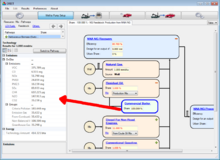
- Technologies Emissions : This is the total Technology emissions of that technology.
- Energy : This is the energy used by the technology
- Misc : This is the technology reference of the technology.
Step Results for transportation processes
Details are available when we click on a step inside this transportation process. Here is a example showing the details for a pipeline process.
Those results on the left a specific to the selected step. For the emissions we show :
- Emissions with Fuels Upstream : this is the total emissions for the steps including the upstream emissions for the fuel used to power the step and the emissions generated on site by the technologies ( usually engines combustion technologies )
- Step OnSite Emissions Only : this collapsed results would show the emissions associated to the technologies used by this process only, no upstream is accounted here. To expand it just double click the "Step OnSite Emissions Only".
- Energy with Fuels Upstream : as we do for the emissions this shows the energy (fuel) consumption of the process and the upstream associated to the production of those fuels.
- Step OnSite Energy Only : show only the energy used by the step without including any upstream.
- Energy Intensities : For each fuel used by the selected step, energy intensities are calculated and displayed here for information purpose.
Graphing Results
Plots are available for viewing graphical representations of Emissions and Energy usage for processes and pathways. To plot emission values right click either "Emissions all Included" or "Emissions" in the property display then click plots and either "Plot values in bar chart" or "Plot values in pie chart".
To plot energy usage by process fuel right click either "Energy All Included" or "Resources" in the property display then click plots and either "Plot values in bar chart" or "Plot values in pie chart".
To plot energy usage by fuel group, right click "Groups" and click "Plot values in bar chart" or "Plot values in pie chart". When viewing pie charts by Fuel Groups, pie pieces will usually include Fossil Fuel and Non Fossil Fuel at the top level. To view sub-pie charts right click on a pie and click "View Sub-Groups".
Pie Chart Features
Pie charts display the selected results by the percentage of each emission or fuel amount and displays the corresponding pie pieces. Mousing over a pie slice will display the value of the emission or fuel for that piece of the pie. Right clicking on the chart displays options for copying the chart as an image, saving the image to the hard disk, and printing the image. Clicking "Copy data to clipboard" will allow copying the data that the plot was created with to Excel or another application. Left of the plot is a checkbox which allows combining small values into a single "Others" pie slice. To use this enter the desired percent value you would like to combine from into the textbox and make sure the checkbox is checked.
Bar Chart Features
Bar charts display the selected results by the original amounts for each emission of fuel amount. The emission name or fuel name is displayed at bottom with their associated amounts as bars going up from their names. Mousing over a bar will display its associated amount. Clicking and dragging a box around a portion of the chart allows zooming the graphing region to that part of the graph. Holding the middle mouse button down and dragging around the graphing region allows panning around the chart. To undo these effects right click and select "Undo All Zoom/Pan". Right clicking on the chart displays options for copying the chart as an image, saving the image to the hard disk, and printing the image. Clicking "Copy data to clipboard" will allow copying the data that the plot was created with to Excel or another application. Left of the plot is a checkbox which allows switching the y-axis scale to a logarithmic scale.
Pathways and Mixes (WTP)
The well to pump results allow viewing and comparing the energy usage and emission results for each of the pathways in each of the mixes for a LDV fuel.
The tabular version of the results displays the energy usage and emissions for each pathway as well as the weighted average of the values based on the share of each pathway. The pathways that are displayed depends on what is selected on the left material selection control. Hold shift or control and then select another pathway to choose which pathways are shown. If the resulting material is selected then each pathway within each mix is displayed on the right as well as the weighted results for the mix. The column header represents this by starting with either "PATH" for pathway results or "SRC" for the mix results. Selecting a single pathway will display the energy used and emissions for each process within the pathway each denoted by "PROC" in the result table. The results can be exported by right clicking and selecting "Copy to Clipboard" or "Save to XML File". Once copied the results can either be pasted into Excel or a text editor.
The graphical format of the results allows seeing the pathways as they feed into a mix of the resulting LDV fuel. Each of the pathways displayed on the left of the graphic with their name and share amount as well as the emissions displayed on the left of the panel and the energy displayed on the right. The source box then shows the weighted mix results from combining the output of the pathways.


